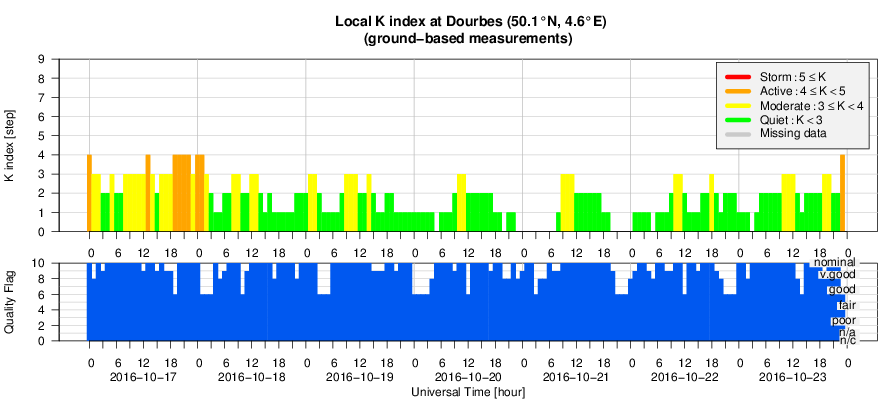- Table of Content
- 1.Corresponding ...
- 2.PROBA2 Observa...
- 3.Review of sola...
- 4.The internatio...
- 5.Review of geom...
- 6.Geomagnetic Ob...
- 7.Review of iono...
- 8.Future Events
2. PROBA2 Observations (17 Oct 2016 - 23 Oct 2016)
3. Review of solar activity
4. The international Sunspot Number
5. Review of geomagnetic activity
6. Geomagnetic Observations at Dourbes (17 Oct 2016 - 23 Oct 2016)
7. Review of ionospheric activity (17 Oct 2016 - 23 Oct 2016)
8. Future Events
Corresponding Astronomer
And the title of ‘Corresponding Astronomer of the Royal Observatory of Belgium’ goes to …. Prof Jean Lilensten.
Jean Lilensten, research director of CNRS at the University of Grenoble, is a welcome guest at the Observatory and the Solar-Terrestrial Centre of Excellence.
In 2003, he stood at the cradle of the European Space Weather Week, an annual science conference which has been organized by the STCE for the last 10 years. Anno 2016, the ESWW has become the hallmark of international space weather conferences in Europe. Jean has the talent to connect fields in science: from planetology, over physics of the higher atmosphere and plasmasphere, solar physics, study of the ionosphere, to space weather. If there is a link, Jean sees it and exploits it.
Jean is the co-founder of the Journal of Space Weather and Space Climate, an international multi-disciplinary and interdisciplinary peer-reviewed journal.
Jean builds firm bridges between science and society, an important way to valorise science. He modernised an early 20th century aurora experiment. As the 21st century Planeterrella godfather, he brought the fascinating world of space and plasma science into the life of students and many other people. He sees the popularisation of science as a ‘must’, and he adds that extra on top of it. He brings the beauty of science not only into class rooms but also into living rooms. For this simple reason: in his view, science is art.

Through Jean, one can read, feel, see, and live science. Our collaboration with him is definitely an added value to ROB and even to the whole Space Pole. We hope that the future years will be as fruitful as the past ones!
PROBA2 Observations (17 Oct 2016 - 23 Oct 2016)
Solar Activity
Solar flare activity fluctuated between very low and low during the week.
In order to view the activity of this week in more detail, we suggest to go to the following website from which all the daily (normal and difference) movies can be accessed: http://proba2.oma.be/ssa
This page also lists the recorded flaring events.
A weekly overview movie can be found here (SWAP week 343).
http://proba2.oma.be/swap/data/mpg/movies/weekly_movies/weekly_movie_2016_10_17.mp4
Details about some of this week's events, can be found further below.
If any of the linked movies are unavailable they can be found in the P2SC movie repository here
http://proba2.oma.be/swap/data/mpg/movies/
Monday Oct 17
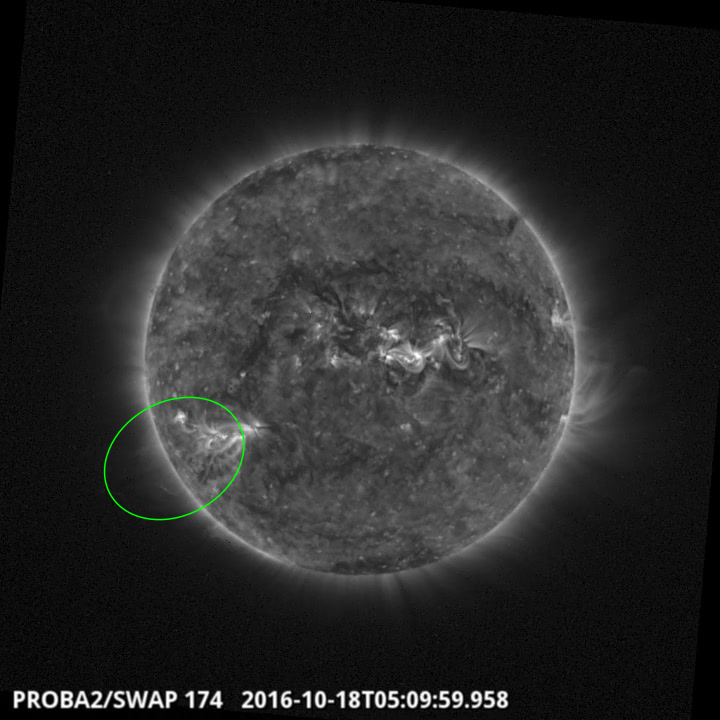
An eruption was observed by SWAP on the east limb of the Sun on 2016-Oct-18 at 05:09 UT
Find a movie of the event here (SWAP movie)
http://proba2.oma.be/swap/data/mpg/movies/20161018_swap_movie.mp4
Review of solar activity
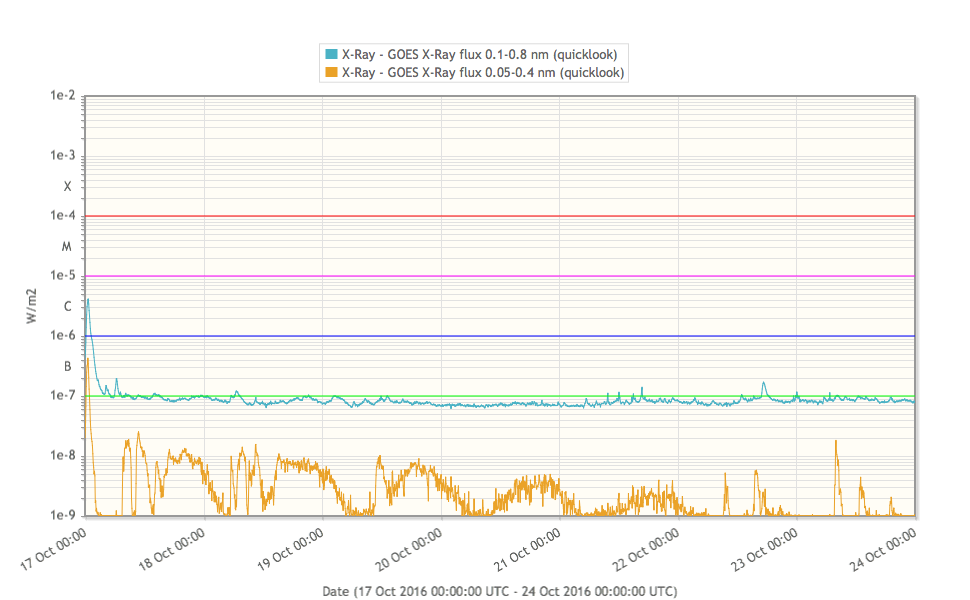
Over the past week solar activity was low. The largest flare recorded was a C4.2 class flare. Solar protons have remained at background levels over the past week. No Earth directed Coronal Mass Ejections (CMEs) have been detected. There was a small CME produced by/near AR 2602 (Macintosh class:Axx; Mag. type:Alpha) on 23-Oct-2016, which was located on the West Solar limb.
The international Sunspot Number
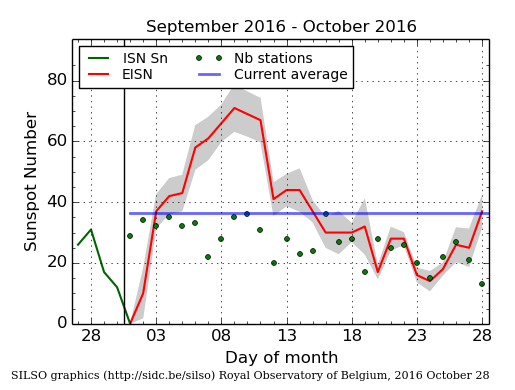
The daily Estimated International Sunspot Number (EISN, red curve with shaded error) derived by a simplified method from real-time data from the worldwide SILSO network. It extends the official Sunspot Number from the full processing of the preceding month (green line). The plot shows the last 30 days (about one solar rotation). The horizontal blue line shows the current monthly average, while the green dots give the number of stations included in the calculation of the EISN for each day.
Review of geomagnetic activity
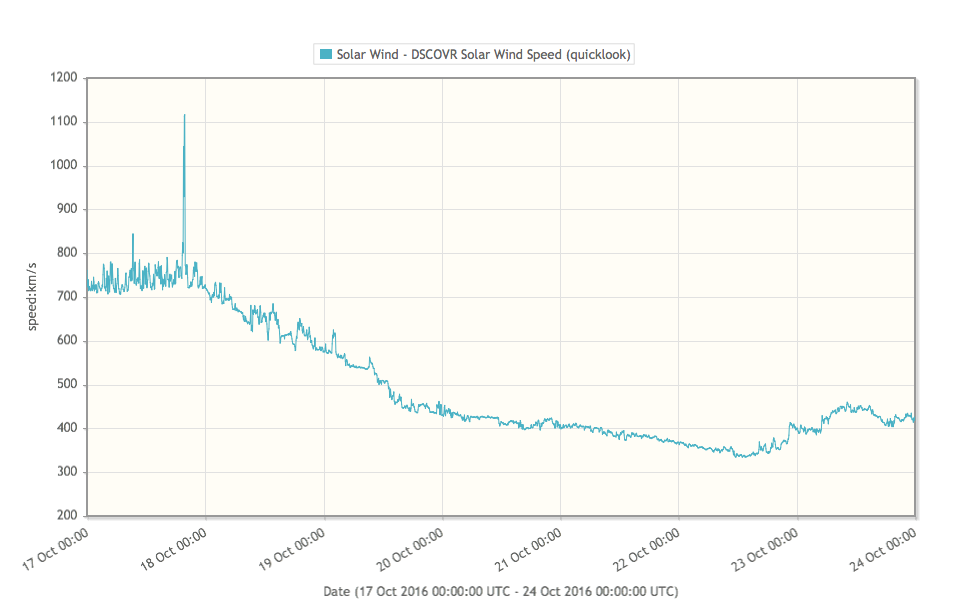
The solar wind speed has fluctuated between 340 and 750 km/s over the past week.
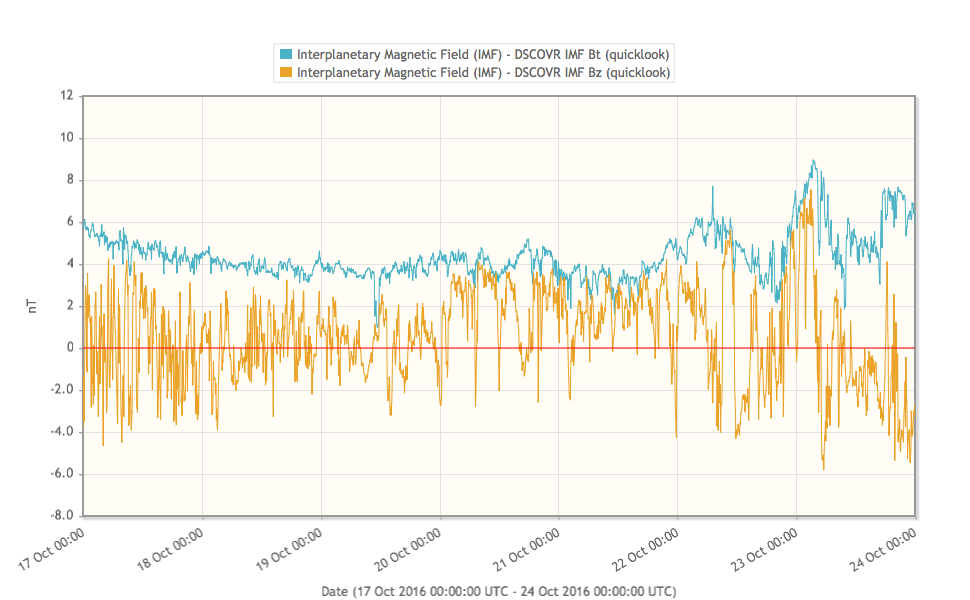
The total magnetic field strength has fluctuated between 3 and 5 nT peaking on 23-Oct-2016. The Bz component fluctuated between -5 and +6 nT. Geomagnetic conditions ranged between Kp index 0-5 (NOAA) and local K index 0-4 (Dourbes) over the past week, but largely remained around the 1 and 2 levels.
Review of ionospheric activity (17 Oct 2016 - 23 Oct 2016)
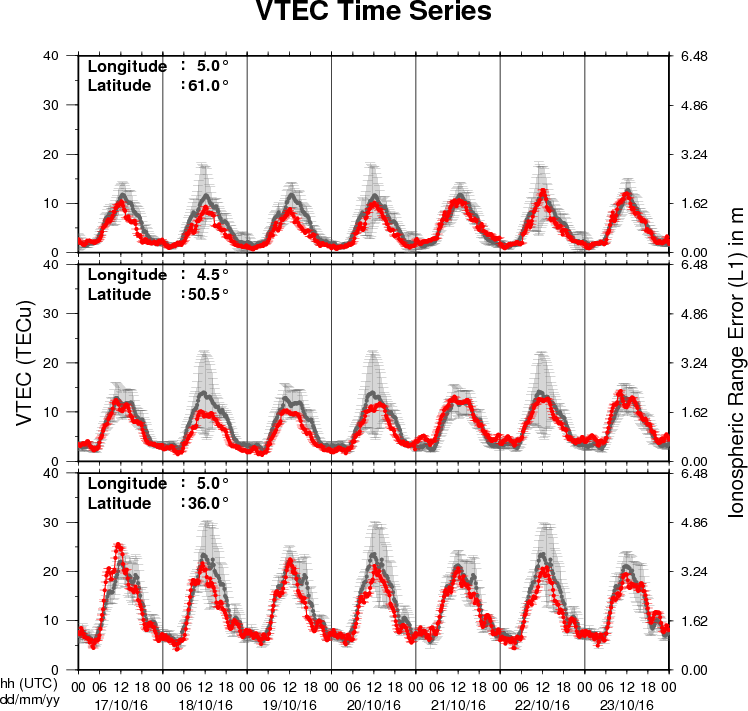
The figure shows the time evolution of the Vertical Total Electron Content (VTEC) (in red) during the last week at three locations:
a) in the northern part of Europe(N61°, 5°E)
b) above Brussels(N50.5°, 4.5°E)
c) in the southern part of Europe(N36°, 5°E)
This figure also shows (in grey) the normal ionospheric behaviour expected based on the median VTEC from the 15 previous days.
The VTEC is expressed in TECu (with TECu=10^16 electrons per square meter) and is directly related to the signal propagation delay due to the ionosphere (in figure: delay on GPS L1 frequency).
The Sun's radiation ionizes the Earth's upper atmosphere, the ionosphere, located from about 60km to 1000km above the Earth's surface.The ionization process in the ionosphere produces ions and free electrons. These electrons perturb the propagation of the GNSS (Global Navigation Satellite System) signals by inducing a so-called ionospheric delay.
See http://stce.be/newsletter/GNSS_final.pdf for some more explanations ; for detailed information, see http://gnss.be/ionosphere_tutorial.php
Future Events
For more details, see http://www.spaceweather.eu/en/event/future
European Space Weather Week in Ostend, Belgium
Start : 2016-11-14 - End : 2016-11-18
The ESWW is the main annual event in the European Space Weather
calendar. It is the European forum for Space Weather as proven by
the high attendance to the past editions. The agenda will be
composed of plenary/parallel sessions, working meetings and
dedicated events for service end-users. The ESWW will again adopt
the central aim of bringing together the diverse groups in Europe
working on different aspects of Space Weather.
Website:
http://www.stce.be/esww13/
4th SOLARNET Meeting: The Physics of the Sun from the Interior to the Outer Atmosphere, in Lanzarote (Spain)
Start : 2017-01-16 - End : 2017-01-20
The IV SOLARNET MEETING 'The physics of the Sun from the
interior to the outer atmosphere' will take place in Lanzarote
(Spain) from 16th to 20th of January 2017, organized by the
Instituto de AstrofÃsica de Canarias (IAC).
SOLARNET (High-resolution Solar Physics Network) is an EU-FP7
project coordinated by IAC with the aim of bringing together and
integrating the major European research infrastructures in the
field of high-resolution solar physics. SOLARNET involves all
pertinent European research institutions, infrastructures, and data
repositories. Networking activities, access to first-class
infrastructures and joint research and development activities are
being covered under SOLARNET to improve, in quantity and quality,
the service provided by this European community.
The purpose of this conference is to provide a coherent picture
of the Sun as a single physical system playing all the underlying
physical processes measured and observed in the solar atmosphere to
date.
Website:
http://www.iac.es/congreso/solarnet-4meeting/
Solar Orbiter Workshop 7: Exploring the solar environs in Granada, Spain
Start : 2017-04-03 - End : 2017-04-06
This event will be hosted by the Instituto de Astrofisica de
Andalucia - CSIC. Please mind that on April 7th the 20th SWT
meeting will take place at the same venue.
Website: Unkown
